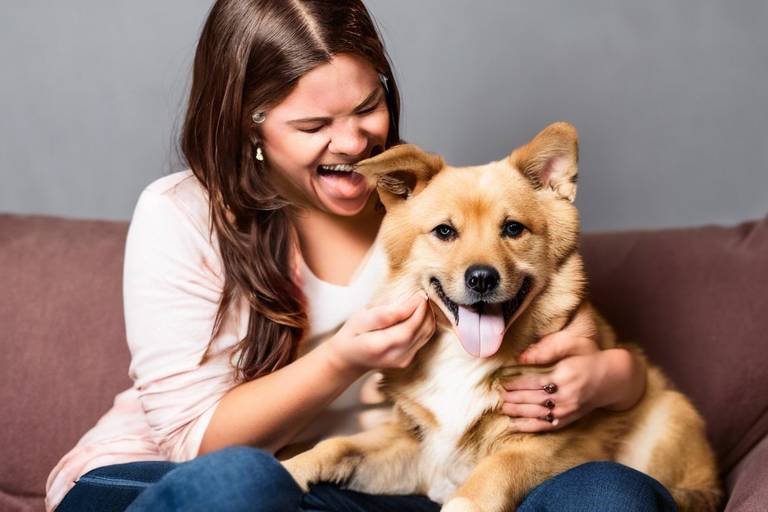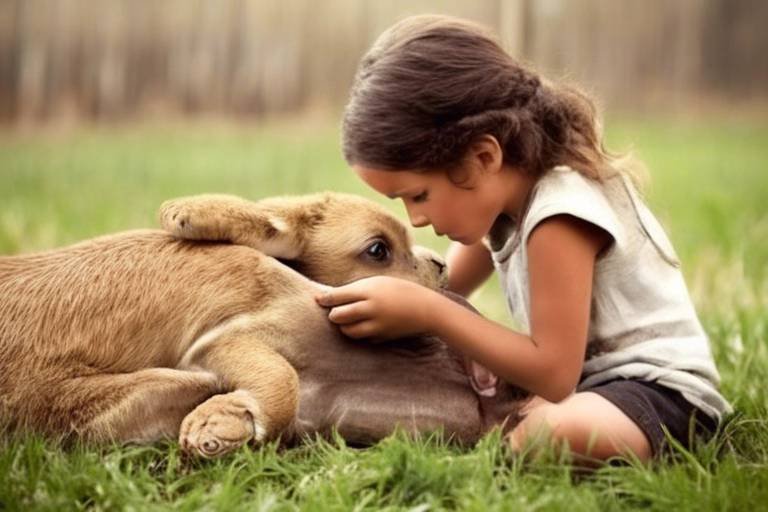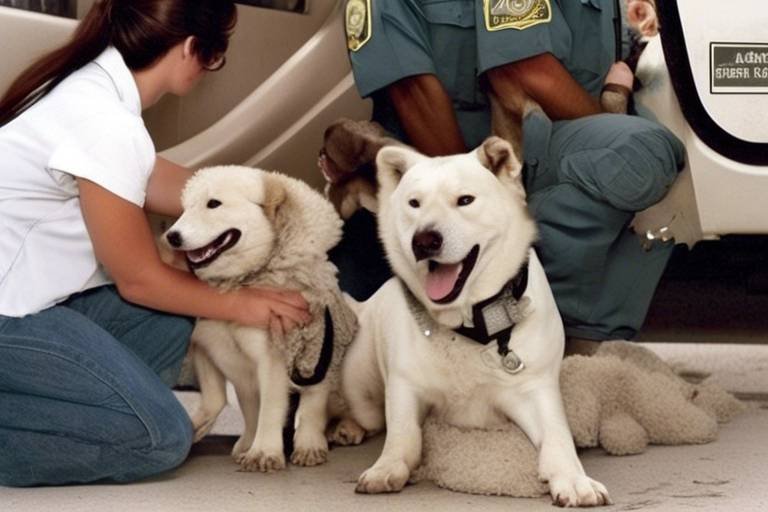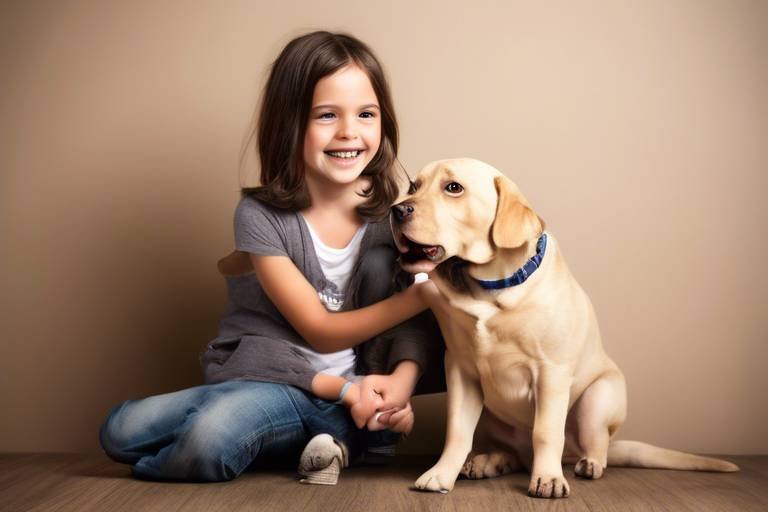How to Prepare for a New Pet’s First Vet Visit
Bringing home a new pet is an exciting adventure filled with joy, cuddles, and a few surprises. However, one of the first things you'll need to tackle is that all-important first visit to the vet. Now, I know what you're thinking: "What could be so complicated about a vet visit?" Well, let me tell you, it’s not just about showing up and saying, “Here’s my pet!” There’s a bit of preparation involved to ensure that both you and your furry friend have a smooth experience. Think of it as a first date; you wouldn’t just show up without any background knowledge, right? You want to impress, and you want your pet to feel comfortable too!
In this article, we’ll dive deep into the essentials of preparing for that first vet visit. From understanding your pet’s unique needs to gathering necessary documents and preparing your pet for the big day, we’ve got you covered. So grab a cup of coffee, settle in, and let’s make sure your new companion’s first vet visit is as stress-free as possible!
Before you even think about stepping foot in the vet's office, it’s crucial to recognize your pet’s specific needs. Each pet is unique, and understanding their breed, age, and any pre-existing health conditions can make a world of difference during the visit. For instance, did you know that certain breeds are more prone to specific health issues? By knowing your pet’s background, you can provide your vet with valuable information that can guide their assessments and recommendations. It’s like giving them a cheat sheet to your pet’s health history!
Additionally, if your pet is a puppy or kitten, they might require different vaccinations and care compared to older pets. So, take some time to research and jot down any pertinent details about your pet’s breed and health. This knowledge will not only help your vet but will also empower you as a responsible pet owner.
Now that you have a better grasp of your pet’s needs, it’s time to gather all the necessary paperwork. Having the right documents ready can significantly streamline your vet visit, making it a breeze instead of a chaotic scramble. Here are some essential documents you should consider bringing along:
- Adoption Papers: If you adopted your pet, these papers are crucial for your vet to know their background.
- Vaccination Records: These documents show what vaccinations your pet has already received.
- Previous Medical History: Any past medical issues or treatments should be documented to provide context for your vet.
Vaccination records are not just a piece of paper; they are vital for your pet's health. They help your vet assess your pet's immunization status and determine what vaccinations may still be necessary. Imagine going to the doctor without your medical history—confusing, right? That’s what it’s like for your vet without these records!
Keeping your pet’s vaccines current is crucial for their protection. Outdated vaccinations can expose your furry friend to various diseases, some of which can be quite severe. Think of vaccines as a shield; without them, your pet is vulnerable to potential threats. By staying on schedule with vaccinations, you not only protect your pet but also contribute to the overall health of the pet community.
If you find yourself lacking vaccination records, don’t panic! There are steps you can take to obtain them. Reach out to previous owners or the shelter where you adopted your pet. Most shelters keep detailed records, and they’ll be more than happy to assist you in retrieving this information. It’s like going back to school to gather your transcripts—necessary for your future success!
Providing a comprehensive health history is equally important. Take some time to compile relevant information about your pet's past medical issues and treatments. This could include any allergies, surgeries, or medications your pet has had. The more information you provide, the better equipped your vet will be to make informed decisions about your pet’s care.
So, before the visit, consider jotting down a timeline of your pet’s health. This will not only help your vet but also give you peace of mind knowing you’ve covered all bases.
Getting your pet ready for the vet visit involves more than just logistics. It’s all about making them feel comfortable and secure. After all, a calm pet is a happy pet! One of the best ways to achieve this is by familiarizing your pet with their carrier. If your pet associates the carrier with fun and comfort, they’ll be less anxious when it’s time to hit the road.
To make the carrier a safe and inviting space, try leaving it open in a familiar area of your home. Toss in some treats or their favorite toys, and let your pet explore it at their own pace. This way, they’ll start to see the carrier as a cozy retreat rather than a scary box. It’s like creating a little den for them—who wouldn’t want that?
Understanding how to ease your pet's stress is essential. Consider using calming sprays or pheromone diffusers designed for pets. These can create a soothing environment that helps reduce anxiety. Additionally, bringing along some favorite treats can work wonders! It’s like having a little piece of home with you, reassuring your pet that everything is going to be okay.
Knowing what happens during the vet visit can ease your concerns and prepare you for the experience. Typically, the visit will start with an initial assessment, where the vet will check your pet’s weight, temperature, and overall health. It’s a bit like a health check-up for humans, where the doctor gathers essential information to understand how you’re doing.
During this initial phase, your vet will conduct a thorough examination. They’ll check your pet’s eyes, ears, and mouth, listen to their heart, and feel their abdomen. This is a critical time for your vet to get a baseline understanding of your pet’s health. It’s all about gathering data to ensure your furry friend is in tip-top shape!
Familiarizing yourself with common procedures can help you prepare for what’s to come. Expect vaccinations, examinations, and possibly some tests if your vet has concerns. Knowing what to anticipate can make the whole process less daunting. It’s like going into a movie knowing the plot; you’ll feel more at ease!
After the vet visit, proper care is essential for your pet's health. Make sure to follow any instructions given by your vet regarding medication, diet, or activity levels. Monitoring your pet’s recovery is vital, as it allows you to catch any signs of discomfort or adverse reactions early on. Think of yourself as a detective, always on the lookout for clues about your pet’s well-being!
Keep an eye on your pet for any changes in behavior or health. If they seem lethargic or show signs of discomfort, don’t hesitate to reach out to your vet. It’s better to be safe than sorry!
Regular vet visits are crucial for ongoing health. Schedule follow-up appointments as advised by your vet and maintain a consistent health check routine for your pet. This proactive approach will help ensure your furry friend lives a long, healthy, and happy life.
Q: What should I bring to my pet's first vet visit?
A: Bring any necessary documents such as adoption papers, vaccination records, and a list of your pet’s medical history.
Q: How can I reduce my pet's anxiety during the vet visit?
A: Acclimate your pet to their carrier and consider using calming sprays or bringing their favorite treats to create a comforting environment.
Q: What should I expect during the vet visit?
A: Expect an initial assessment, which includes checking your pet’s weight, temperature, and a thorough examination. Your vet may also administer vaccinations or conduct tests.
Q: How often should I take my pet to the vet?
A: Regular vet visits are essential, and it’s typically recommended to schedule check-ups at least once a year. Puppies and kittens may require more frequent visits for vaccinations.

Understanding Your Pet's Needs
When you welcome a new pet into your home, it's like opening a new chapter in your life. However, before you dive headfirst into this exciting journey, it's essential to take a step back and truly understand your pet's unique needs. Just like humans, pets come with their own set of requirements based on their breed, age, and any pre-existing health conditions. This knowledge can make a world of difference when it comes to their well-being and comfort.
First and foremost, each breed has its own characteristics and health concerns. For instance, larger breeds like Great Danes may be predisposed to certain health issues such as hip dysplasia, while smaller breeds like Chihuahuas might face dental problems. Knowing your pet's breed can help you anticipate potential health issues and take proactive measures. Additionally, age plays a significant role; just like us, pets have different needs at various life stages. Puppies and kittens require more frequent vet visits and vaccinations compared to older pets who may need regular check-ups to monitor chronic conditions.
Moreover, it's crucial to gather information about any pre-existing health conditions. If your new furry friend has a history of allergies or previous illnesses, this information is vital for your vet to provide the best possible care. A comprehensive understanding of your pet's health history can help in creating a personalized care plan that addresses their unique needs.
To better illustrate the importance of understanding your pet's needs, consider the following key points:
- Breed-Specific Traits: Research the breed to understand common health issues.
- Age Considerations: Tailor care based on whether your pet is a puppy, adult, or senior.
- Health History: Collect any documents regarding past medical treatments or conditions.
In summary, taking the time to understand your pet's needs not only enhances their quality of life but also strengthens the bond between you and your new companion. By being informed about their breed, age, and health history, you can make informed decisions that lead to a happier, healthier pet. So, as you prepare for that first vet visit, remember that knowledge is power, and the more you know, the better equipped you’ll be to advocate for your furry friend.

Gathering Necessary Documents
When you're preparing for your new pet's first vet visit, one of the most crucial steps is gathering all the necessary documents. Having the right paperwork on hand not only makes the process smoother but also helps the veterinarian provide the best care for your furry friend. Think of it as packing for a trip—if you forget something essential, it can lead to complications down the road.
First and foremost, you'll want to collect your pet's adoption papers. These documents are not just a formality; they often contain important information about your pet's background, including their breed and age. Understanding your pet's history can help the vet make informed decisions regarding their care.
Next on the list are the vaccination records. These records are vital for assessing your pet's immunization status. If your pet has received vaccinations in the past, the vet will need to know what they are to avoid over-vaccination, which can be harmful. If you're unsure about your pet's vaccination status, don't hesitate to reach out to the previous owner or the shelter where you adopted them. They can provide you with the necessary documentation.
Vaccination records are not just a piece of paper; they are a roadmap to your pet's health. These documents detail what vaccinations your pet has received and when they were administered. This information is crucial for the vet to assess your pet's immunity against various diseases. Without these records, your vet might have to start from scratch, which can be both time-consuming and stressful for you and your pet.
Keeping your pet's vaccines current is essential for their protection. Outdated vaccinations can leave your pet vulnerable to diseases that could have been easily prevented. For instance, diseases like parvovirus and distemper can be deadly, particularly in young or immunocompromised pets. Staying on schedule with vaccinations not only safeguards your pet but also contributes to the overall health of the community by preventing outbreaks of contagious diseases.
If you find yourself lacking vaccination records, don't panic! There are several steps you can take to obtain them. Start by contacting the shelter or rescue organization from which you adopted your pet. They often keep detailed records of the animals they place in homes. If you adopted from a private owner, reach out to them as well. In some cases, you may even be able to contact the veterinarian who previously cared for your pet if you have their contact information. Remember: it's always better to have too much information than not enough when it comes to your pet's health.
Providing a comprehensive health history is another vital part of the documentation process. This includes any past medical issues, treatments, or surgeries your pet may have undergone. Even if your pet seems perfectly healthy now, knowing their medical history can help the vet spot potential issues before they become serious. Compile this information in a simple format, perhaps in a table like the one below:
| Medical Issue | Treatment | Date |
|---|---|---|
| Ear Infection | Antibiotics | January 2022 |
| Allergy | Special Diet | March 2022 |
By keeping track of your pet's medical history and being prepared with the necessary documents, you can ensure that their first vet visit is as seamless as possible. This preparation not only aids the vet in delivering optimal care but also helps you feel more confident and involved in your pet's health journey.
Vaccination Records
When you welcome a new pet into your home, one of the most important documents you need to have on hand is their vaccination record. These records are not just a piece of paper; they are your pet's health passport. They provide crucial information about the vaccines your pet has received, ensuring they are protected against various diseases. It's essential to understand that each breed and age group may have different vaccination needs, so being informed is key.
Vaccination records are vital for several reasons. First and foremost, they help your veterinarian assess your pet's current immunization status. This assessment is crucial during the first visit, as it allows the vet to determine whether your pet needs any immediate vaccinations or boosters. In addition, these records can help identify any potential health risks based on your pet's vaccination history.
Here are some key points to remember about vaccination records:
- Legal Requirement: In some regions, it is a legal requirement to have proof of vaccinations for pets, especially for rabies.
- Travel Necessities: If you plan to travel with your pet, many places require up-to-date vaccination records to ensure the safety of all animals involved.
- Preventative Care: Keeping an accurate record of vaccinations helps in planning future vet visits and ensuring your pet remains healthy.
In summary, vaccination records are not just a formality; they are a crucial part of your pet's health management. Make sure to keep these documents organized and readily accessible, as they will play a significant role in your pet's healthcare journey.
Importance of Up-to-Date Vaccines
When it comes to keeping your furry friend healthy, up-to-date vaccines are nothing short of a superhero cape. Just like we humans need our vaccinations to fend off nasty bugs, pets require theirs to protect against a range of diseases that can be harmful or even fatal. Imagine your pet as a knight in shining armor, and the vaccines as the enchanted shield that helps them fight off invading infections!
One of the most critical reasons to ensure your pet's vaccinations are current is to prevent outbreaks of diseases that can spread rapidly among animals. For instance, diseases like parvovirus and distemper can wreak havoc on a pet's health, and the best defense is a strong offense—vaccination. Keeping your pet's vaccines up to date not only protects them but also contributes to the overall health of the pet community. When more pets are vaccinated, the chances of disease outbreaks diminish significantly, creating a safer environment for all.
Additionally, many dog parks, pet boarding facilities, and grooming salons require proof of vaccination before allowing pets to enter. This requirement is not just a formality; it’s a crucial step in ensuring that all pets are protected from potential health risks. If your pet's vaccines are not current, you might find yourself unable to participate in fun activities, like a day at the dog park or a weekend getaway at a pet-friendly hotel. So, keeping those vaccinations up to date is not just about health—it's also about enjoying life with your pet!
Let’s take a closer look at the benefits of having up-to-date vaccines in a simple table:
| Benefit | Description |
|---|---|
| Prevention of Diseases | Vaccines protect against serious diseases that can affect your pet's health. |
| Community Health | Higher vaccination rates help prevent outbreaks, protecting all pets in the area. |
| Access to Facilities | Many pet services require proof of vaccination for entry. |
| Peace of Mind | Knowing your pet is protected allows you to relax and enjoy your time together. |
In conclusion, keeping your pet's vaccinations up to date is essential for their health, the safety of other pets, and your ability to engage in various activities. Don't wait until it's too late; make sure to schedule those vet visits and keep your pet's vaccination records in check. After all, a happy pet is a healthy pet, and nothing beats the joy of watching your furry friend thrive!
How to Obtain Missing Records
Finding missing vaccination records for your new pet can feel like searching for a needle in a haystack, but it’s crucial for their health and safety. If you’ve adopted your furry friend from a shelter or a previous owner, the first step is to reach out to them. Most reputable shelters keep detailed records of the animals they adopt out, including vaccination histories. A quick call or email can often yield the information you need.
If you’re unable to get in touch with the original owner or shelter, don’t panic! Your next best option is to consult your local veterinarian. They can perform a physical examination and may recommend starting a new vaccination schedule based on your pet’s age and health status. This way, your pet will still be protected even if you can’t provide the previous records.
Another avenue to explore is online databases. Some veterinary clinics have adopted digital record-keeping, making it easier to access your pet’s information. If your pet was previously seen by a vet, ask if they have an online portal where you can retrieve their vaccination history. This is especially useful if your pet has moved around a lot before finding their forever home.
In some cases, it may be necessary to get your pet re-vaccinated if records are completely unattainable. While this might seem like a hassle, it can actually provide peace of mind knowing that your pet is protected against preventable diseases. Just remember to keep a copy of any new vaccination records in a safe place to avoid this situation in the future!
To summarize, here are the steps you should follow to obtain missing vaccination records:
- Contact the shelter or previous owner for information.
- Consult a local veterinarian for a health assessment.
- Check if there are online databases available for retrieving records.
- Consider re-vaccination if records cannot be found.
By taking these steps, you can ensure that your new pet is up-to-date on their vaccinations, keeping them healthy and safe. Remember, being proactive about your pet’s health is one of the best gifts you can give them!
1. What should I do if I can't find my pet's vaccination records?
If you can't find your pet's records, start by reaching out to the shelter or previous owner. If that doesn't work, consult your veterinarian for an assessment and possible re-vaccination.
2. How important are vaccination records?
Vaccination records are crucial for ensuring your pet is protected from diseases. They help your vet determine what vaccinations are needed and when.
3. Can my pet be vaccinated without prior records?
Yes, your vet can evaluate your pet's health and create a vaccination plan even without prior records. It's always better to be safe than sorry!
4. How often should my pet see the vet?
Regular check-ups are essential. Generally, adult pets should visit the vet at least once a year, while puppies and kittens may need more frequent visits.
Health History Overview
When it comes to your pet's health, knowledge is power. Providing a comprehensive health history is not just a formality; it's a crucial step in ensuring your veterinarian has all the information needed to give your furry friend the best possible care. Before your visit, take some time to gather details about your pet's past medical issues, treatments, and any medications they may have been prescribed. This background can significantly influence the vet's approach to your pet's health.
Start by compiling any previous medical records you have. If you adopted your pet from a shelter or a previous owner, they might have provided some documentation regarding past vaccinations, illnesses, or treatments. If you don't have these records, don't worry! You can often contact the shelter or previous owner to request this information. Having a clear picture of your pet's health history can help your vet identify potential risks and tailor their examination accordingly.
Additionally, consider jotting down any behavioral changes you've noticed, such as changes in appetite, energy levels, or bathroom habits. These observations can be incredibly valuable to your vet. They might point to underlying health issues that need to be addressed. Think of it like piecing together a puzzle; every little detail helps create a clearer picture of your pet's overall health.
It's also essential to keep track of any allergies your pet may have. Some pets react adversely to certain foods, medications, or environmental factors. If your pet has had any allergic reactions in the past, be sure to inform the vet during the visit. This information can help prevent any potential complications during examinations or treatments.
To make things easier, you might consider preparing a simple table to summarize your pet's health history. Here's a quick example of what that could look like:
| Health Aspect | Details |
|---|---|
| Previous Illnesses | List any past illnesses or conditions. |
| Medications | Include any medications your pet has been prescribed. |
| Vaccination Status | Document the dates and types of vaccinations. |
| Allergies | Note any known allergies or sensitivities. |
By taking the time to prepare this information, you not only facilitate a smoother visit but also empower your vet to make informed decisions about your pet's care. Remember, your veterinarian is your partner in your pet's health journey. The more they know, the better they can help!
- What should I bring to my pet's first vet visit? It's essential to bring any previous medical records, vaccination history, and a list of any medications your pet is currently taking.
- How can I help my pet feel more comfortable during the visit? Acclimating your pet to their carrier and using calming sprays or treats can help ease their anxiety.
- What if I don't have any medical history for my adopted pet? Contact the shelter or previous owner to obtain any available records. Your vet can also perform a thorough examination to assess your pet's health.

Preparing Your Pet for the Visit
Getting your furry friend ready for their first vet visit is more than just packing a bag and heading out the door. It’s about creating a positive experience that sets the tone for all future trips to the vet. Just like you wouldn’t want to walk into a new place without knowing what to expect, your pet deserves the same consideration. So, how do you ensure your pet feels comfortable and safe during this potentially stressful outing? Let’s dive into some practical strategies that can help.
First things first, you’ll want to help your pet get used to their carrier. Think of the carrier as a cozy little den, a safe space where they can feel secure. Start by leaving the carrier out in your home with the door open, allowing your pet to explore it at their own pace. You can make it more inviting by placing their favorite blanket or a couple of treats inside. This way, they’ll associate the carrier with comfort and positivity, rather than just a vehicle to the vet. If you notice your pet hesitating, try gently coaxing them with treats or toys. The goal is to make the carrier feel like a second home.
Another critical aspect to consider is managing your pet’s anxiety. Just like humans, pets can feel nervous about new experiences. You might wonder, “What can I do to calm my pet down?” There are several techniques you can employ. For instance, consider using calming sprays that are designed specifically for pets. These sprays often contain ingredients like lavender, which can have a soothing effect. Additionally, you can reward your pet with treats during the process to reinforce positive behavior. If you have time, practice short car rides leading up to the vet appointment. This helps them get accustomed to the motion and sounds of traveling, making the actual trip to the vet less daunting.
Don’t forget to familiarize yourself with your pet's behavior. Understanding their body language can be incredibly helpful. For instance, if they seem overly clingy or start hiding, those are signs of stress. On the flip side, if they’re curious and exploring, that’s a good sign! Use this knowledge to adjust your approach. If your pet is particularly anxious, consider bringing along a favorite toy or blanket to provide comfort during the visit.
Lastly, it’s essential to prepare yourself for the visit as well. Have a list of questions ready to discuss with the vet. You might want to ask about your pet's diet, exercise needs, or any behavioral concerns you’ve noticed. This not only helps you feel more confident but also ensures you get the most out of your appointment. Remember, the vet is there to help, and being proactive can lead to better health outcomes for your pet.
In summary, preparing your pet for their first vet visit involves a mix of acclimatization, anxiety management, and personal preparation. By taking these steps, you’re setting the stage for a smoother experience, which can make all the difference in your pet’s attitude towards future vet visits.
- How early should I start preparing my pet for the vet visit? It’s best to start at least a week in advance to allow your pet to get used to the carrier and the idea of going to the vet.
- What should I bring to the vet appointment? Bring your pet’s vaccination records, any previous medical history, and a list of questions you want to ask the vet.
- Can I feed my pet before the visit? Yes, but be cautious with pets prone to motion sickness. It might be better to have a light meal a few hours before the appointment.
- What if my pet is extremely anxious? Consult your vet about possible calming medications or strategies if your pet has severe anxiety.
Acclimating to the Carrier
Acclimating your new pet to their carrier is a crucial step in ensuring a stress-free visit to the vet. Imagine being confined in a small space without any prior warning—it's no wonder many pets feel anxious when they first encounter their carriers! To make this experience as smooth as possible, start by introducing the carrier well in advance of the vet visit. Place the carrier in a common area of your home where your pet usually hangs out. This will help them associate the carrier with a safe and familiar environment.
Next, consider making the carrier a cozy haven for your furry friend. You can add a soft blanket or a favorite toy inside. This simple act can transform the carrier from a scary box into a comforting retreat. Encourage your pet to explore the carrier by leaving the door open and allowing them to go in and out at their own pace. You might even sprinkle some treats inside to entice them further. Remember, the goal is to create positive associations with the carrier, so shower them with praise and affection whenever they show interest in it.
Additionally, you can practice short trips around the house or even to the car to help your pet get used to the motion of being transported. Start with just a few minutes and gradually increase the duration. This helps your pet adapt to the sensation of being in the carrier while also allowing you to monitor how they react. If they seem particularly anxious, you might want to try calming sprays or pheromone diffusers that can help ease their nerves. Just like humans, pets can benefit from a little extra support during potentially stressful situations.
Lastly, be patient. Every pet is different, and some may take longer to acclimate than others. The key is to remain calm and supportive throughout the process. With time and positive reinforcement, your pet will learn to view their carrier as a safe and comfortable space, making future vet visits much less daunting. Remember, preparation is everything—just like a well-packed suitcase for a vacation, a well-acclimated carrier can make all the difference in your pet's experience.
- How long should I acclimate my pet to the carrier? It's best to start acclimating your pet at least a week before the vet visit to allow them ample time to adjust.
- What if my pet refuses to enter the carrier? Try enticing them with treats and toys, and ensure the carrier is comfortable. Patience is key!
- Can I use calming products for my pet? Yes, calming sprays and pheromone diffusers can be effective in reducing anxiety during the acclimation process.
Managing Stress and Anxiety
Taking your pet to the vet for the first time can be a nerve-wracking experience—not just for you, but for your furry friend as well. Imagine being in a new place filled with unfamiliar sounds, smells, and people. It’s no wonder pets can feel stressed and anxious! But don’t worry; there are several strategies you can employ to help ease your pet’s nerves and make the visit as smooth as possible.
First and foremost, familiarization is key. Before the big day, let your pet explore the carrier or crate where they’ll be transported. A little bit of time spent in their new ‘den’ can work wonders. You might want to place their favorite blanket or a few toys inside to make it feel more like home. The goal is to create a safe and inviting space that your pet associates with comfort rather than confinement.
Next, consider using calming products to help reduce anxiety. There are various options available, including sprays, diffusers, and collars infused with calming pheromones. These products can help create a soothing atmosphere for your pet. Additionally, you can try giving your pet some special treats before the visit. Treats can serve as a positive reinforcement, helping them associate the vet with something enjoyable rather than something to dread.
Another effective technique is desensitization. This involves gradually exposing your pet to the sights and sounds they might encounter at the vet’s office. You can play recordings of vet office sounds at a low volume while providing treats and praise. Over time, increase the volume and duration to help your pet become accustomed to the noises they will hear during their visit. This method can significantly reduce anxiety levels and help them feel more at ease.
Lastly, don’t underestimate the power of your own demeanor. Pets are incredibly perceptive and can pick up on their owner's emotions. If you’re anxious, your pet may become anxious too. Try to remain calm and collected. Use a soothing voice when speaking to your pet, and don’t forget to shower them with love and reassurance throughout the process. Your confidence can help them feel secure.
- Familiarize your pet with their carrier ahead of time.
- Use calming products to create a soothing environment.
- Practice desensitization with sounds from the vet’s office.
- Stay calm and positive during the visit.
By implementing these strategies, you'll be setting both yourself and your pet up for a more relaxed experience at the vet. Remember, preparation is key, and with a little effort, you can transform a potentially stressful situation into a manageable one. Your furry companion will thank you for it!
Q1: How can I tell if my pet is stressed during the vet visit?
A1: Signs of stress in pets can include panting, excessive barking or meowing, hiding, or attempting to escape. Pay attention to their body language; ears pinned back and a lowered tail can also indicate anxiety.
Q2: Are there specific calming products recommended for pets?
A2: Yes! Products like Adaptil (for dogs) or Feliway (for cats) are popular options. Additionally, consider natural supplements like calming chews or treats that contain ingredients such as chamomile or valerian root.
Q3: Should I take my pet to the vet if they show signs of anxiety?
A3: Yes, it’s essential to address anxiety issues. If your pet is consistently anxious, consult your veterinarian for advice and potential solutions, which may include behavioral training or medication.
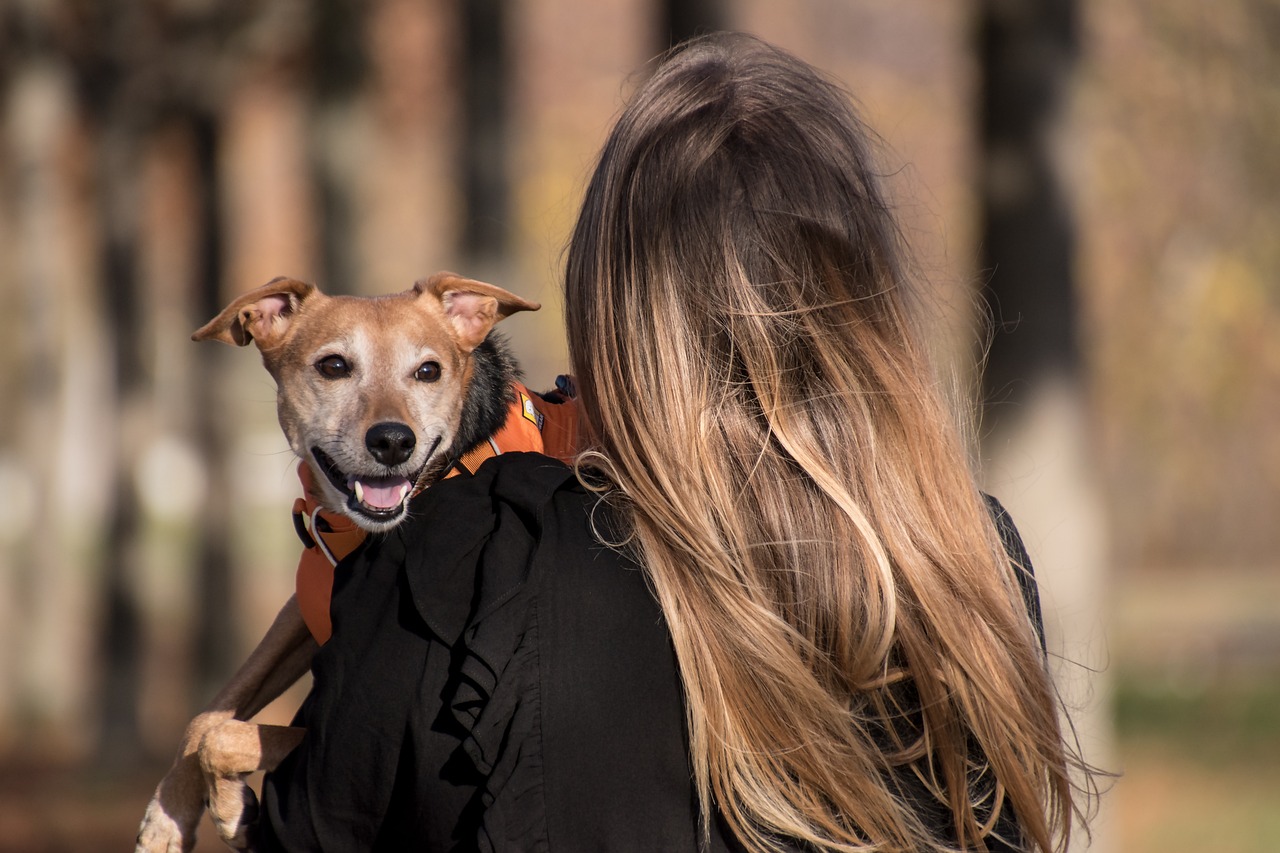
What to Expect During the Visit
When you finally step into the vet’s office with your furry friend, it can feel a bit overwhelming. But don’t worry! Understanding what to expect during this visit can transform your anxiety into confidence. First things first, as soon as you walk in, you’ll be greeted by the friendly staff who will ask you to fill out some forms. This is your chance to provide important information about your pet, including any concerns you might have. Remember, this is a partnership; the more you share, the better they can help.
Once the paperwork is done, the vet will conduct an initial assessment. This is a crucial first step in understanding your pet’s health. During this phase, your vet will check your pet's weight, temperature, and general demeanor. For example, they might ask questions like, “Has your pet been eating and drinking normally?” or “Have you noticed any unusual behavior?” These questions help the vet gauge your pet’s overall well-being. It’s a bit like a first date, where you both get to know each other better!
Next up, you can expect a thorough examination. The vet will physically check your pet from nose to tail. They’ll look at their eyes, ears, and mouth, feel their abdomen, and check their skin and coat condition. This part might feel a little daunting, especially if your pet is squirmy, but rest assured that this is standard procedure. It’s all about ensuring your pet is in tip-top shape! If any concerns arise during the examination, the vet will discuss them with you and may suggest further tests or treatments.
One of the most common procedures during a first visit is vaccinations. Your vet will review your pet’s vaccination history and determine which shots are needed. Keeping your pet up-to-date on their vaccines is crucial for preventing diseases. It’s like giving them a shield against potential health threats. If your pet needs vaccinations, the vet will explain each one, including its purpose and any possible side effects. This way, you’ll leave the office feeling informed and empowered!
Finally, after the examination and any necessary procedures, the vet will provide you with a summary of your pet’s health status and recommendations for follow-up care. They may suggest scheduling additional appointments, especially if your pet is due for more vaccinations or needs ongoing treatment. This is also a great time to ask any lingering questions you might have. Don’t hesitate! Your vet is there to help you and your pet live their best lives.
- What should I bring to my pet’s first vet visit? Bring any relevant paperwork, such as adoption papers and vaccination records, along with a list of any questions or concerns you have.
- How long will the visit take? Typically, a first vet visit can last anywhere from 30 minutes to an hour, depending on the complexity of your pet’s needs.
- What if my pet is anxious about the visit? Consider using calming sprays or treats, and allow your pet to explore the carrier beforehand to reduce stress.
Initial Assessment Process
When you walk into the vet's office with your new furry friend, it can feel a bit overwhelming. But fear not! The is designed to be thorough yet straightforward, ensuring that your pet gets the best possible care. The vet will start by gathering some basic information about your pet, which includes their name, age, breed, and any known health issues. This information is crucial as it helps the vet tailor their approach to your pet’s specific needs.
Next, your pet will undergo a series of evaluations that are essential for establishing a health baseline. These assessments typically include:
- Weight Check: Monitoring your pet's weight is vital because it can indicate overall health and help identify any potential issues early on.
- Temperature Reading: Just like humans, pets can have fevers. The vet will take your pet's temperature to check for any signs of infection or illness.
- Heart Rate and Respiratory Rate: The vet will listen to your pet's heart and lungs, ensuring everything is functioning as it should. Abnormalities can signal underlying health problems.
During this process, it’s important to remain calm and supportive. Pets can pick up on their owner's anxiety, which may increase their own stress levels. If your pet seems nervous, try to soothe them with gentle words or a comforting touch. The vet may also ask you about your pet’s diet, behavior, and any changes you’ve noticed since bringing them home. This information can provide valuable insights into their health and well-being.
Finally, once the initial assessments are complete, the vet will discuss their findings with you. This is a great opportunity to ask questions and voice any concerns you might have. Remember, this visit is not just about checking off boxes; it’s about establishing a trusting relationship between you, your pet, and the veterinary team. So, don’t hesitate to engage in a conversation about your pet’s health and any preventive measures you can take moving forward.
Common Procedures Explained
When you take your new pet to the vet, it can feel a bit overwhelming, especially if you're unsure about what to expect. Understanding the common procedures that usually occur during a vet visit can help ease your mind and prepare you for the experience. The first thing you’ll likely encounter is an initial assessment, where the vet will perform a general check-up. This includes weighing your pet and taking their temperature, which are crucial for establishing a baseline of their health. Think of it like a wellness check-up for humans; it sets the stage for everything that follows.
Next, your vet will conduct a thorough physical examination. They will check your pet's eyes, ears, and mouth, looking for any signs of infection or abnormalities. The vet will also listen to your pet's heart and lungs with a stethoscope, ensuring that everything sounds normal. This is a fantastic opportunity for you to ask questions about your pet's health, behavior, and any concerns you may have.
Another essential part of the visit often includes vaccinations. Vaccines are like a shield for your pet, protecting them from various diseases. Depending on your pet's age and previous vaccination history, the vet may administer several shots during this visit. It's important to understand which vaccines are necessary for your pet, as they can vary by age, breed, and lifestyle. For example, puppies and kittens require a series of vaccinations, while adult pets may only need boosters for specific diseases.
In addition to vaccinations, your vet may recommend certain tests based on your pet's health history or current symptoms. These tests can include blood work, urinalysis, or even x-rays to diagnose underlying issues. While the idea of tests can sound daunting, they are essential for ensuring your pet's well-being. Just like humans, pets can have hidden health problems that only a vet can identify through these diagnostic procedures.
Lastly, it's worth mentioning that your vet will likely provide you with information on preventative care. This can include advice on nutrition, exercise, and dental care, which are all vital components of your pet's overall health. Remember, the vet is your partner in keeping your furry friend happy and healthy, so don’t hesitate to engage in a conversation about their diet or lifestyle.
In summary, a vet visit typically includes:
- Initial assessment (weight and temperature checks)
- Physical examination (eyes, ears, mouth, heart, and lungs)
- Vaccinations (based on age and health status)
- Diagnostic tests (if necessary)
- Preventative care advice
Understanding these procedures can transform your anxiety into excitement as you know you're taking the right steps for your pet's health. It’s all about ensuring they live a long, happy life by your side!
Q: How can I prepare my pet for the vet visit?
A: Acclimate your pet to their carrier and consider using calming sprays or treats to reduce anxiety.
Q: What should I bring to the vet?
A: Bring any necessary documents such as vaccination records, adoption papers, and a list of your pet's health history.
Q: How often should my pet see the vet?
A: Regular check-ups are recommended at least once a year, but more frequent visits may be necessary for younger pets or those with health issues.
Q: What vaccinations does my pet need?
A: Vaccination needs vary by age, breed, and lifestyle. Your vet will provide a tailored vaccination schedule for your pet.

Post-Visit Care and Follow-Up
After the excitement of your pet's first vet visit, it’s crucial to focus on post-visit care to ensure their continued well-being. Think of this phase as the after-party; the fun isn't over yet! Just like you would check in on a friend after a big event, you should monitor your pet closely. This will help you catch any potential issues early on and give your furry friend the best chance at a happy, healthy life.
First and foremost, monitoring your pet's recovery is essential. After vaccinations or any procedures, your pet may feel a bit off. Look for signs of discomfort, such as lethargy, loss of appetite, or unusual behavior. It’s important to remember that while some mild reactions are normal, anything that seems out of the ordinary should be discussed with your vet. To help you keep track, consider maintaining a simple log of your pet’s behavior and any changes you notice.
Here’s a quick checklist of signs to monitor:
- Changes in appetite
- Excessive sleeping or lethargy
- Vomiting or diarrhea
- Signs of pain (whining, hiding, etc.)
Next, schedule any follow-up appointments as recommended by your vet. Regular check-ups are vital for your pet's health, especially in the first year. Think of these visits like regular tune-ups for a car; they help catch any issues before they become serious. Your vet may suggest a schedule based on your pet’s age, breed, and health condition. It’s always better to be proactive than reactive!
Also, don't forget about medication administration if your vet has prescribed anything. Make sure to follow the dosage instructions carefully. If your pet is anything like mine, they might be a little tricky to medicate. Here are a few tips to make this process smoother:
- Try hiding the medication in a treat or food they love.
- Use a pill pocket if they are particularly picky.
- Stay calm and positive; your pet can sense your energy!
Finally, keep an eye on their recovery and any behavioral changes. Pets are masters at hiding discomfort, so being observant is key. If you notice anything unusual, don’t hesitate to reach out to your vet. They would much rather address a minor concern than deal with a major issue later on.
Q: How soon should I schedule a follow-up visit after the first vet appointment?
A: It depends on your pet's health needs. Generally, follow-up visits are recommended within a few weeks, especially if vaccinations were given.
Q: What should I do if my pet has a reaction to a vaccine?
A: Monitor your pet closely. If you notice severe symptoms like swelling, difficulty breathing, or excessive vomiting, contact your vet immediately.
Q: How can I make my pet more comfortable after the vet visit?
A: Create a cozy space at home with their favorite blanket or toy, and give them plenty of love and attention. Sometimes, a quiet environment helps them relax.
Monitoring Recovery
After your pet's visit to the vet, the real journey begins. It’s essential to keep a close eye on how they’re recovering. Just like we need time to bounce back after a check-up, our furry friends do too. Monitoring their recovery isn’t just about ensuring they’re comfortable; it’s about catching any potential issues before they escalate. So, what should you be looking for? Here are some key signs to keep in mind:
- Behavior Changes: Watch for any shifts in your pet's behavior. Are they more lethargic than usual? Or perhaps they’re unusually restless? These changes can signal discomfort or pain.
- Appetite: Is your pet eating and drinking normally? A sudden loss of appetite can be a red flag, especially after a procedure.
- Physical Symptoms: Keep an eye out for any swelling, redness, or discharge from the surgical site or vaccination area. These could be signs of infection or an adverse reaction.
- Bathroom Habits: Changes in urination or defecation can indicate underlying issues. Make sure your pet is able to go to the bathroom normally.
In addition to these signs, it’s wise to set a schedule for checking in on your pet. Create a daily routine where you assess their mood, appetite, and any physical symptoms. This not only helps you stay on top of their recovery but also strengthens the bond between you and your pet. Think of it as a daily check-in, like a quick chat with a friend to see how they’re feeling after a tough day.
Moreover, don’t hesitate to reach out to your vet with any concerns. They’re there to help, and it’s better to ask than to worry in silence. If your pet shows any alarming symptoms, such as excessive vomiting, difficulty breathing, or extreme lethargy, contact your veterinarian immediately. Remember, you know your pet best, and your instincts are a valuable tool in monitoring their health.
Lastly, ensure that your pet has a comfortable and quiet space to recover. Create a cozy corner with their favorite blanket and toys, away from noise and distractions. This safe haven can make a world of difference in how quickly they bounce back. Just like us, pets need a little TLC after a vet visit, so shower them with love and attention as they heal.
1. How long does it take for my pet to recover after a vet visit?
Recovery time varies depending on the procedure. Minor vaccinations may require just a day or two, while surgeries can take a week or more. Always consult your vet for specific timelines.
2. What should I do if my pet won’t eat after the vet visit?
If your pet refuses to eat for more than 24 hours, contact your veterinarian. They may suggest ways to entice your pet to eat or check for underlying issues.
3. When should I be concerned about my pet's recovery?
Contact your vet if you notice any severe symptoms such as excessive bleeding, swelling, or signs of pain. Early intervention can prevent complications.
4. Is it normal for my pet to be more tired after a vet visit?
Yes, it’s common for pets to feel tired or a bit out of sorts after a vet visit, especially if they received vaccines or anesthesia. However, monitor their energy levels closely.
5. How can I help my pet feel more comfortable during recovery?
Provide a quiet, comfortable space, offer their favorite toys, and give them plenty of love and attention. You can also use calming sprays or treats to help reduce anxiety.
Scheduling Future Appointments
Once your furry friend has had their first vet visit, you might think you can relax for a while. But hold on! Just like humans need regular check-ups, your pet requires a consistent health monitoring schedule to ensure they stay in tip-top shape. Scheduling future appointments is not just a formality; it’s a crucial part of maintaining your pet's health and well-being.
So, how do you go about this? First, it’s essential to understand the recommended timeline for your pet's check-ups. For puppies and kittens, the vet might suggest visits every few weeks for vaccinations and health assessments until they reach a certain age. Adult pets, on the other hand, typically need to be seen at least once a year, but some pets may require more frequent visits based on their health needs or age. Here’s a quick breakdown:
| Pet Age | Recommended Vet Visits |
|---|---|
| Puppies/Kittens (0-6 months) | Every 3-4 weeks |
| Adult Pets (1-7 years) | Once a year |
| Senior Pets (7+ years) | Every 6 months |
After your initial visit, it’s a good idea to ask your vet when to schedule the next appointment before you leave. This way, you can ensure that you don’t miss any important vaccinations or health checks. Mark your calendar, set reminders on your phone, or even use a pet care app to keep track of these dates. It’s all about staying proactive!
Additionally, don’t forget to keep an eye on your pet’s health between visits. If you notice any changes in behavior, appetite, or energy levels, don’t hesitate to call the vet. Sometimes, issues can arise unexpectedly, and it’s better to address them sooner rather than later. Regular communication with your vet can help you make informed decisions about your pet's health.
Finally, remember that scheduling future appointments is not just about vaccinations or routine check-ups. It’s also an opportunity to discuss any concerns you might have or to get advice on diet, exercise, or behavioral issues. Your vet is there to help you navigate the journey of pet ownership, so don’t hesitate to utilize their expertise!
- How often should I take my pet to the vet? - Generally, puppies and kittens need more frequent visits, while adult pets typically need annual check-ups. Senior pets may require biannual visits.
- What should I bring to my pet's vet appointment? - Bring any medical records, vaccination history, and a list of any symptoms or concerns you have noticed.
- Can I schedule multiple appointments at once? - Yes! It's often easier to schedule several appointments at once, especially if you have multiple pets.
- What if my pet needs more frequent visits? - Your vet will guide you on the frequency of visits based on your pet's health status and needs.
Frequently Asked Questions
- What should I bring to my pet's first vet visit?
For your pet's first vet visit, it's essential to bring documents like adoption papers, vaccination records, and any previous medical history. Having this paperwork ready can help the vet understand your pet's background and health needs better.
- How can I help my pet feel comfortable in the carrier?
To make your pet comfortable in the carrier, start by introducing it at home. Leave the carrier open with some treats or favorite toys inside to create a positive association. Gradually allow your pet to explore it without any pressure.
- What can I expect during the initial assessment?
During the initial assessment, the vet will check your pet's weight, temperature, and general health. This step is crucial for understanding your pet's overall condition and addressing any concerns you might have.
- How often should I schedule vet visits for my pet?
Generally, it's recommended to schedule a vet visit at least once a year for healthy pets. However, puppies and kittens may require more frequent check-ups, and pets with health issues may need regular visits based on their specific needs.
- What if I don't have my pet's vaccination records?
If you don't have your pet's vaccination records, don't worry! You can contact the shelter or previous owner to obtain them. It's also a good idea to ask the vet about getting your pet vaccinated again if records are unavailable.
- How can I manage my pet's anxiety during the visit?
To manage your pet's anxiety, consider using calming sprays or treats before the visit. Additionally, practice desensitization by taking short trips in the car to the vet's office, allowing your pet to become familiar with the environment.
- What follow-up care should I provide after the vet visit?
After the vet visit, monitor your pet for any signs of discomfort or adverse reactions, especially if they received vaccinations. It's also crucial to follow any medication instructions provided by the vet and schedule any recommended follow-up appointments.





